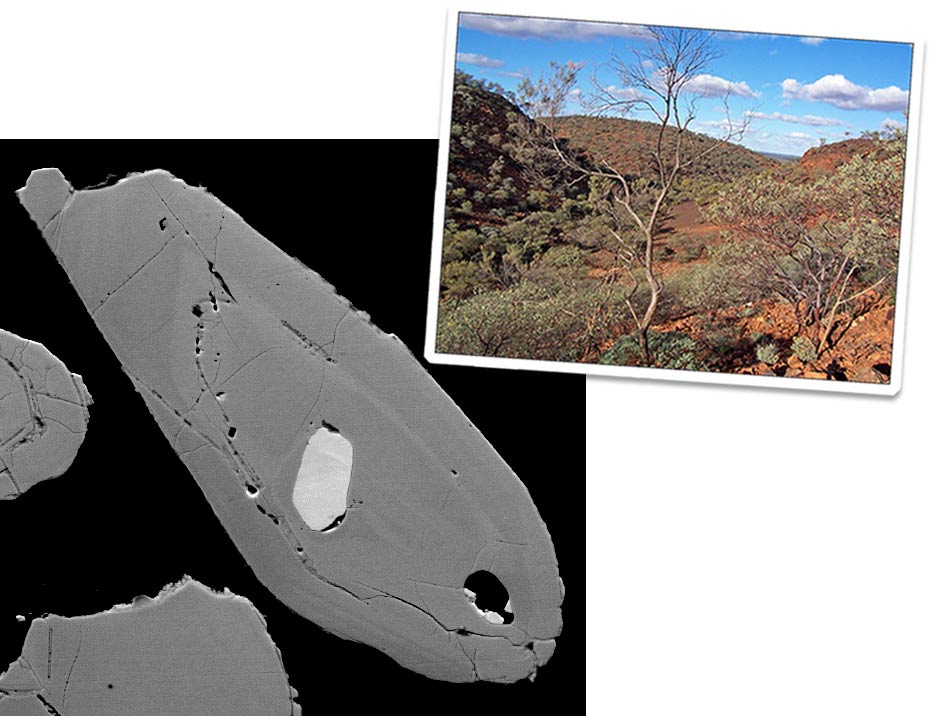
Found in rocks throughout Earth's crust, zircons are some of the oldest bits of mineral on Earth. These tiny crystals are so durable - and some are so ancient, dating to just 150 million years or so after our world formed - that geologists have long viewed the tiny bits of minerals embedded within them as a kind of time capsule, offering a peek at conditions on the early Earth. But a new study suggests that these so-called inclusions are not as pristine as scientists thought, raising doubts about conclusions that researchers have drawn from them, from the rise of early oceans to the movements of the ancient continents.
In the new study, researchers led by geologist Birger Rasmussen of Curtin University in Bentley, Australia, analyzed more than 7000 zircons from a portion of the Jack Hills of Western Australia, where rocks are between 2.65 billion and 3.05 billion years old. These zircons ended up in the Jack Hills rocks after eroding from rocks that were even more ancient, and the researchers painstakingly sorted the individual crystals from other bits of minerals. Many of the individual, centimeter-sized pebbles in the silicate-rich conglomerate have been heavily metamorphosed - stretched, flattened, and sometimes chemically altered when tectonic activity carried them deep within Earth, where pressures and temperatures are hellish. Zircons in the rocks were exposed to the same conditions. "These zircons have been absolutely hammered," Rasmussen says.
A total of 485 zircons held inclusions, and about a dozen or so of these contained radioactive trace elements that allowed the researchers to determine their ages. Those ages fell into two clumps - one of about 2.68 billion years and another of about 800 million years. "This was a big surprise to us," Rasmussen says, especially because the zircons themselves ranged in age from 3.34 billion and 4.24 billion years old.
Rather than matching the ages of the zircons, the researchers note, the ages of the inclusions matched the ages of the metamorphic minerals surrounding the zircons. Some of those inclusions lie along hairline fractures in the zircons, a route by which mineral-rich fluids could have infiltrated, Rasmussen says. But other inclusions appear to be entirely enclosed. In those cases, the fluids may have traveled along defects in the zircon's crystal structure caused by radioactive decay or along pathways that are either too small to see or oriented such that they're invisible.
In recent years, some researchers have used analyses of zircons and their inclusions - and in particular, the temperatures and pressures they've been exposed to since their formation - to infer the presence of oceans or of modern-style plate tectonics on Earth more than 4 billion years ago, well before previously suspected, Rasmussen says. But based on the team's new findings, which will be reported next month in Geology, those conclusions are suspect, he notes.
"This paper will stir people up," says Ian Williams, an isotope geochemist at Australian National University in Canberra. "These results make it much less likely that Jack Hills zircons were involved in plate tectonics." The team's results "suggest that analyses of zircon inclusions can't be trusted much at all," adds Jonathan Patchett, an isotope geochemist at the University of Arizona in Tucson. "This is really nice work, very strong."
Still, Allen Nutman, a geochemist at the University of Wollongong in Australia, says that although the work casts doubt on some zircon inclusions, others may still provide valuable information. "You don't have to throw away information, you just have to be careful what you do with it."
A high proportion of zircon inclusions are made up of phosphate minerals called apatite, Williams says. If that type of mineral is missing from all of the zircons in a particular sample, he notes, that's a clue that the inclusions may have been chemically altered.



Reader Comments
to our Newsletter